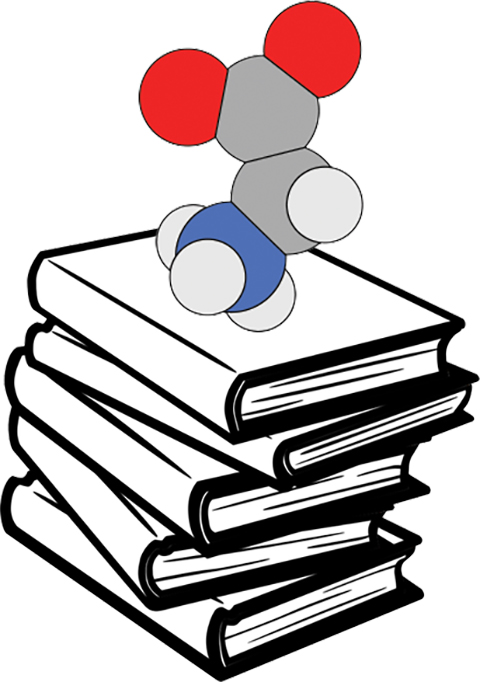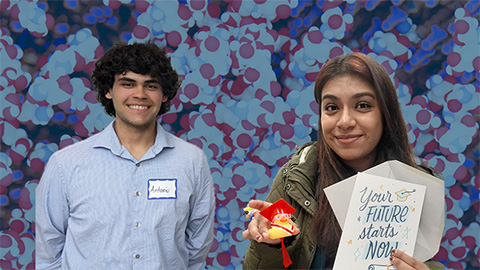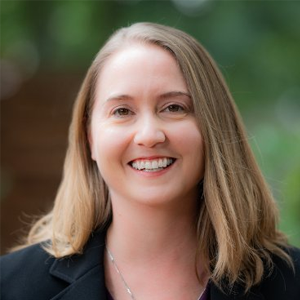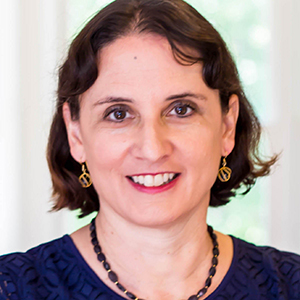Ten years in the making
In life science classrooms such as biochemistry, instructors show figures of cells, organelles and macromolecules in various ways; for example, the outline of a protein’s surface may be used to illustrate its binding to another molecule, then the representation of that same protein changed to a cartoon to highlight its secondary structure. However, instructors don’t always tell students how to interpret an image or explain why a scientist might choose to represent a biological structure one way over another. Whether a student sees what their instructor expects them to see in an image depends on the student’s visual literacy — their ability to extract meaning from details that are both explicitly and implicitly displayed.

At the 2013 American Society for Biochemistry and Molecular Biology Education Meeting in Seattle, a group of BMB educators began discussing the challenges students face when interpreting these biological images. The group agreed that visual literacy requires more deliberate instruction than we often provide, and they recognized that this ability is so foundational in the molecular life sciences that a learner can’t effectively progress in the field without developing it; it is what Jenny Loertscher and the other authors of a 2017 paper in CBE—Life Sciences Education termed a “threshold concept.”
That meeting is where BioMolViz originated.
After that beginning, Paul Craig of the Rochester Institute of Technology started hosting online meetings to continue these conversations, long before Zoom was a mainstay in our lives. The team, scattered across the U.S., worked to create tools that would help other instructors address visual literacy in their own classrooms.
In 2017, Craig and others published a scaffold of learning objectives, the BioMolViz Framework. Then, the group sought funding to host workshops that would teach educators how to use the framework to write questions to evaluate students’ visual literacy. We intended to make the assessment questions broadly available for any interested BMB instructor to use in their classroom, and we wanted a central place to house these assessments. Importantly, an educator new to teaching and evaluating visual literacy should be able to easily identify learning objectives that fit their instruction and search for associated questions.
A decade after that first meeting, BioMolViz launched our library of instructor tools. To mark that accomplishment, we offer our individual perspectives — and some reflections from other members of the community.
KP Procko: A reluctant director
I joined BioMolViz at an exciting time. Dan Dries of Juniata College had taken over from Craig and secured the team’s first round of funding in 2017. With one year to prove ourselves, BioMolViz planned to hold workshops where faculty could write and revise assessments to evaluate students’ visual literacy skills. We figured that eventually we’d have so many ideas, we’d need to organize them in a searchable repository.
In 2018, I reluctantly agreed to take over the directorship of BioMolViz. As a non–tenure-track faculty member, I was at an uncertain time in my career. Plus, a big part of the role would be overseeing the construction of our repository. How would 10 educators with almost no experience in database design build this thing?
According to our most tech-savvy member, Alberto Roca of DiverseScholar, we needed project management software and a database structure; the repository should be a place to accept, review, revise and publish assessments. However, we reached the end of our first round of funding with an architecture of Google Drive folders and subfolders containing great assessment questions, each classified by a specific labeling system, but with no repository to house them.
This is when I became director.
Our meetings were filled with discussions about how we should — and should not — move the repository forward. It seemed we needed to make some dramatic changes to our process, but deliberations about that process had stopped us in our tracks. It occurred to me that perhaps this team wasn’t comfortable jumping into new project management software when we were just figuring out how to craft assessments. Heck, it had taken months to convince everyone to make the switch from massive email chains to streamlined communication in Slack.
At that moment, I decided to do something … anything. We don’t know which software to use, so let’s start without it. How could we comfortably make progress? Our temporary solution was a giant, inelegant Excel spreadsheet linking to Google folders — it wasn’t pretty, but it let us move forward.
Early in 2020, we secured a four-year grant and found an external evaluator, Shelly Engelman of Custom EduEval LLC, who helped us develop a plan to ensure the assessments were high quality. Separate teams of faculty would write and revise assessments in workshops. An expert panel that was removed from the project would then review the questions, and finally, they’d be tested by students in classrooms. Data from each step of the process would be used to improve or rethink the assessment. Riding high on the promise of interactive, in-person meetings, we began to seek workshop hosts. And then the pandemic hit.
We were already versed in online meetings, so online workshops were a straightforward pivot. With a surplus of travel funds lying around, we invited participants to work with us remotely after the workshops for additional stipends.
This was the secret sauce. A one-time workshop was a great start, but weekly working groups really put the wheels in motion. The assessments moved forward at a pace we’d never experienced. The workflow was haphazard, but no one seemed to mind. The weekly groups gave us time to develop our process, create detailed documentation and, maybe most importantly, build a community to discuss teaching, commiserate about the challenges we were experiencing and become friends.
That’s how the first group of BioMolViz Fellows emerged — a team of educators working together to build this repository.
Pamela Mertz: From sabbatical workshop to leadership
I attended the first BioMolViz brainstorming meeting in Seattle — an informal circle of engaged educators talking excitedly about how to teach biomolecular visualization. I was always interested, and I checked out their workshops at ASBMB meetings, but I couldn’t commit to more involvement.
That changed in December 2020 when I participated in an online workshop. I was on sabbatical and — as many things pandemic related — my sabbatical was not what I had anticipated; travel and social interactions were limited, and my son did school at home for much of the year.
I felt isolated, and I found a community in BioMolViz through a regular working group. Led by BioMolViz Steering Committee member Margaret Franzen, our team included Roderico Acevedo of Westfield State University, Charmita Burch of Georgia Gwinnett College and me. Franzen was a whiz at manipulating a giant spreadsheet of assessments with the constant goal of better organization while we added more items. We met almost weekly and worked on revising and writing new assessments. We had fun and we valued the project. As a bonus, the leaders of BioMolViz recognized our dedication by naming us fellows.
After I joined the steering committee in 2022, I got a bird’s eye view of the project. People talked about platforms I’d never heard of. Only then did I realize what the group was trying to do — build this searchable, organized public database to house all of these assessments we had been working on.
My husband, Johnathan Steere, is an application architect with database design experience. During a BioMolViz steering committee meeting, I thought to myself, could he help?
I connected KP Procko and Josh Beckman of the University of Texas at Austin, project PI, with Johnathan in May 2022. He suggested we could save money on the development process by creating mock-ups for the application. Soon after that, KP was reporting on progress with developers.
At a steering committee meeting in Austin this past January, we actually worked in the repository, sending and receiving feedback from the developer as he made updates.
About a month later, KP sent out a simple newsletter to the community, announcing the launch of the BioMolViz Library. It included the logo our working group had created the week before, and it said so much: The repository was open for business.
A keystone for community and professional development
We asked others involved in BioMolViz to tell us what the work has meant to them. Members of the working group that began in early 2021 said they shared a commitment to the project and a need for community, and these motivations continued as more people came on board.
“The friends that I made during the workshop (pandemic-times) helped me improve my pedagogy and keep my spirits high,” Acevedo said. “Having friends to bounce ideas and strategies made teaching easier and more enjoyable.”
Kristin Fox of Union College commented, “I have been using molecular visualization in my classes for years and was excited to have other people to talk with and to be able to spend more time thinking about the best way to teach and assess molecular visualization.”
Shane Austin of the University of the West Indies said, “It was the first time I felt part of a community of persons interested in visualization and visualization education.”
These individuals and most participants in our workshops are faculty, but others have become engaged in our workshops. Harry T. Rahn 5th, a graduate student at the University of Michigan–Dearborn, was inspired by his love for the intersection of science, art and learning. “I appreciated the valuable feedback I may be able to provide to give a student perspective,” he said.
Many members of the group also noted that working on the library improved their teaching. “I learned better ways to assess student understanding beyond rote memorization,” Burch said. “Helping develop the repository has given me more confidence in writing my own exams.”
Acevedo noted, “My exam questions that have images now include a CPK color key, more concise questions that apply directly to the image, and are images that are color-blind friendly. All of these things I learned from BioMolViz.”
Working group members also commented on the value of a public assessment repository. Austin said, “Resources for teaching visualization are available, and instructors can easily get illustrations and videos from textbooks for lectures. What remained missing to me was really good and accurate assessments that used visualization or tested students’ skills in visualization. Contributing to this repository seems like it could make a big change in that way.”
Burch said, “The ability to search for a variety of questions beyond what is provided with textbooks is invaluable.”
Fox noted, “While molecular visualization is essential to modern biochemistry, it is not emphasized in current biochemistry textbooks. Since most people who teach biochemistry don't have enough experience with it to generate their own assessments, it is crucial to have high quality assessments available if we are going to be able to guide students.”
When given a preview of the library just before it went public, Paul Craig said it exceeded the expectations he had after that Seattle meeting a decade ago.
The importance of building and maintaining the community — in addition to the library — comes through in our current working groups. We take time at the beginning of each meeting to catch up; we discuss teaching and share our triumphs and struggles.
Once our network was established, even a daunting task like building a repository became enjoyable. As Acevedo said, “I have not worked a day at BioMolViz — I have fun making the assessments with my friends every week.”
Enjoy reading ASBMB Today?
Become a member to receive the print edition four times a year and the digital edition monthly.
Learn moreGet the latest from ASBMB Today
Enter your email address, and we’ll send you a weekly email with recent articles, interviews and more.
Latest in Education
Education highlights or most popular articles

Summer research spotlight
The 2025 Undergraduate Research Award recipients share results and insights from their lab experiences.

Debugging my code and teaching with ChatGPT
AI tools like ChatGPT have changed the way an assistant professor teaches and does research. But, he asserts that real growth still comes from struggle, and educators must help students use AI wisely — as scaffolds, not shortcuts.

How AlphaFold transformed my classroom into a research lab
A high school science teacher reflects on how AI-integrated technologies help her students ponder realistic research questions with hands-on learning.

Writing with AI turns chaos into clarity
Associate professor shares how generative AI, used as a creative whiteboard, helps scientists refine ideas, structure complexity and sharpen clarity — transforming the messy process of discovery into compelling science writing.

How undergrad research catalyzes scientific careers
Undergraduate research doesn’t just teach lab skills, it transforms scientists. For Antonio Rivera and Julissa Cruz–Bautista, joining a lab became a turning point, fostering critical thinking, persistence and research identity.

Talk nerdy to me: Communicating research that matters
Master science communication: learn to engage the public, work with the press and explore new careers — from consulting to media — through ASBMB’s Art of Science Communication course.


